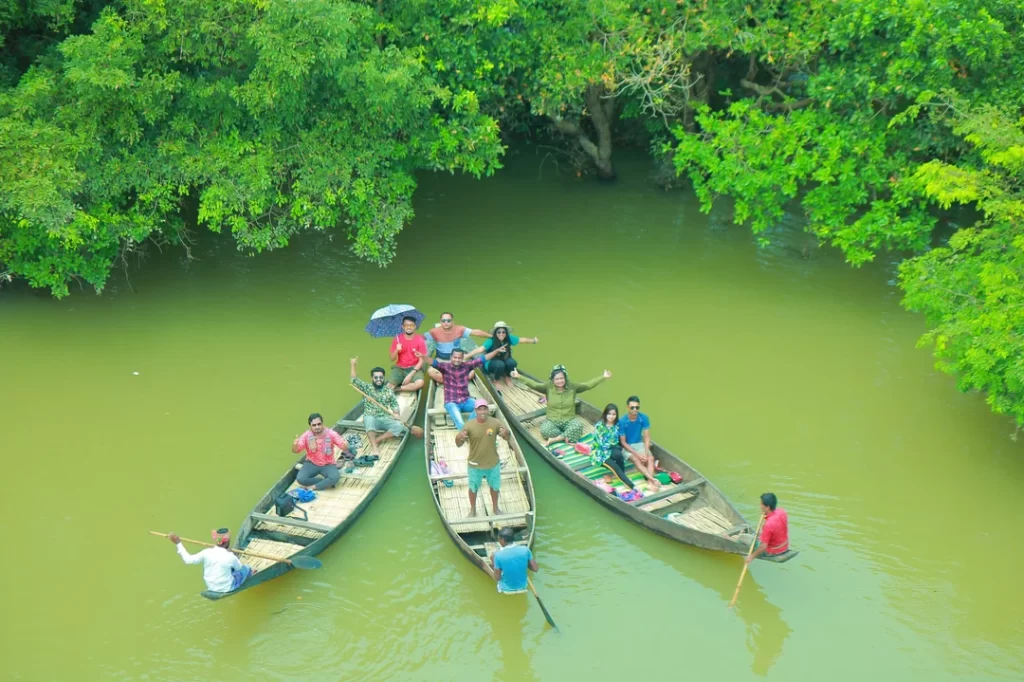
Located in the lush northeastern region of Bangladesh, Ratargul Swamp Forest is a unique and pristine freshwater swamp, distinguished as the only one of its kind in the country. This captivating wetland is a sanctuary for diverse flora and fauna, making it an attractive destination for nature lovers and adventure seekers.
Geography and Climate
Ratargul is situated approximately 26 kilometers from Sylhet, at the base of the Jaintia Hills in India. Spanning around 3.25 square kilometers, the forest features depths ranging from 10 to 15 meters. The Goain River’s seasonal flooding, which gives the surrounding area vital water and nutrients, supports the ecosystem’s uniqueness. The forest’s water levels fluctuate throughout the year, with peak submersion typically occurring from July to October, creating a mesmerizing landscape where only treetops and aerial roots are visible above the water.

Flora and Fauna
Amazing biodiversity can be found in Ratargul. This ecosystem supports more than 70 plant species, including well-known types like kadam (Neolamarckia cadamba), murta (Schumannianthus dichotoma), hijal (Barringtonia acutangula), and koroch (Pongamia pinnata). These species are essential to preserving the forest’s ecological equilibrium.
With about 200 different species living here, the animal life is also quite varied. A variety of reptiles and amphibians, as well as monkeys, otters, and turtles, are visible to visitors. Ratargul is particularly well-known for its abundant birdlife, with over 73 species identified. Among these are the critically endangered Pallas’s fish eagle and the endangered masked finfoot, which makes it a vital breeding ground for numerous migratory birds. The forest is teeming with life for birdwatchers, especially during migration seasons.
Visiting the Forest
To fully appreciate Ratargul’s beauty, exploring the forest by boat is highly recommended. This enables guests to glide across tranquil waters while taking in the rich vegetation and distinctive wildlife. The best time to visit is between July and October, when the forest is completely submerged, creating an otherworldly atmosphere.
It’s crucial to get ready properly before leaving. Wearing comfortable, water-resistant apparel and sturdy footwear is recommended for visitors. Moreover, it’s imperative to pack snacks and beverages because the forest lacks stores or dining establishments. Visitors are encouraged to heed the advice of local guides in order to minimize their impact on this fragile ecosystem, as it is imperative that they respect the environment.

Nearby Attractions
There are a lot of things to do and see in the Ratargul area, which enhances the experience. Embracing the verdant scenery of Sylhet is possible for tourists who cycle through the picturesque tea estates. Interacting with the Khashia and Monipuri communities enhances the visit overall by offering insight into local customs and cultures.
Hikers can explore a different rich ecosystem by hiking through the nearby Lawachara Rain Forest, which has a variety of trails. Another beautiful waterfall that is well worth seeing is Ham Ham Waterfall, which offers a lovely backdrop for leisure and photography. Additional hotspots for birdwatchers can be found at Hail Haor and Baikka Bil Haor, which are well-known for their migratory bird populations.
Take a trip on the Lala Khal or visit the Jaflong Mari River, which is well-known for its natural beauty and stone-collection activities, for a unique experience. Each of these sights enhances Ratargul Swamp Forest’s peace and scenic splendor.

Ratargul Swamp Forest is an ecological wonder that provides a singular fusion of natural beauty, biodiversity, and cultural experiences. It is more than just a place to visit. Ratargul offers a rejuvenating escape from city life, whether you choose to glide through its calm waters, see its colorful wildlife, or visit neighboring attractions. Please get in touch if you would like more information or a customized itinerary!

